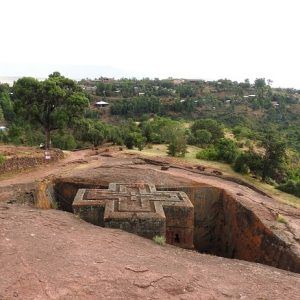The Ethiopian Tawahedo Church has been the official state church of Ethiopia for more than a thousand years. It was already an old institution when King Ezana made Christianity the official state religion back in 330 CE.
More than any other institution in Ethiopia, the Orthodox Tawahedo Church has seen all the intrigues of Ethiopia’s long history. In fact, its origins lay much further back, at a time when Ethiopia was still languishing in the shadows of Egypt.
Egyptian priests descend to Ethiopia
The Ethiopian Orthodox religion was born out of an ingenious mixture of indigenous Ethiopian religious practices, Egyptian gods, and Judaic dogma. However, this blend of religions did not happen spontaneously. It was the result of millennia of trade relations and population admixture.
North of Ethiopia, Egypt underwent a tumultuous couple of decades during the reign of Amenhotep IV, popularly known as Akhenaten or the heretic king.
It was just after 1350 BCE, and the seeds of the Late Bronze Age collapse were being sown. After a long period of peace and prosperity, the priestly class had grown very influential. Their wealth was so great, it rivaled that of the Pharaohs.
While Akhenaten was his father’s regent, Amenhotep III had started religion reforms that sought to cut the influential priestly class down to size. But his reforms were timid compared to his son’s.
Akhenaten started by democratizing learning, which before, had been the exclusive preserve of the priestly class. He then brought control of the extensive and numerous temple estates under the pharaoh, triggering a huge schism between the pharaoh and the priesthood.
But even as he deliberately neglected bilateral relations with Egypt’s powerful northern neighbors, Ethiopia benefited from Akhenaten’s reforms. Akhenaten’s reign stands out as one of a few Egyptian monarchs who carried out building projects in Nubia.
Ethiopian Kings rule Egypt
When the Late Bronze Age collapse happened a few centuries later, Ethiopia’s fortunes had already started looking up. She had just received an injection of premium religion from Egypt, and the ancient kingdom was too weak to maintain its economic choke-hold on her.
Ethiopia had its capital at Seba in present-day Sudan. More importantly, the encroaching Sahara desert was smaller, and vast parts of what is today part of the Nubian Desert were arable lands.
After a few centuries of independence, Nubia was a very powerful kingdom indeed.
The Hyksos in Egypt
In the north of Egypt, a new dynasty of foreign kings had appeared shortly after the Great Bronze Age collapse. Greatly weakened by the LBA collapse, Egypt had sought to prop herself up by welcoming a large immigrant workforce. A good portion of this immigrant community comprised of Israelite Jews.
During the Hyksos dynasties, the Jews in Israel successfully sought the crown of Egypt. This they often did by welcoming pillaging armies to Egypt and picking out what was left for themselves.
But in the 8th century BCE, Nubian kings from the Ethiopian hinterland united in a massive campaign to drive out the invaders. For a few centuries, they called the shots in Egypt.
However, the Ethiopian dynasty was soon driven out of Egypt. After this defeat, subsequent hordes of marauding conquerors visited ruin upon Egypt. First the Assyrians, then the Persians, and finally the Romans exerted their influence on the ancient land.
In their time of rule, Ethiopian rulers of Egypt are attested to have been just as devoted to the Egyptian religion as the native Egyptians themselves. They were not just tolerated there – they were welcomed and celebrated.
Ethiopian indigenous religion
Even though Ethiopian monarchs had deposed Hyksos kings from Egypt, their ties with Israel only grew after the fall of Egypt. Many Jews moved to Ethiopia, to establish a lasting Jewish presence there.
The Lemba people are attested descendants of ancient Jewish peoples. Their genetic composition attests to this fact. Their history tells of an ancient passage through Ethiopia with their own version of the Ark of the Covenant – the Ngoma Lungundu.
However, the Lemba are not the only Ethiopian Jews. Another Ethiopian Jewish group – The Falashas have their own brand of Judaic practices – more evidence of a long history of bilateral ties between Ethiopia and Israel going back ages.
After the Queen of Sheba tour of Israel, religious links between Ethiopia and Israel deepened. A trade route through the Southern Arabia region was opened, which brought much prosperity to the kingdom. At the height of the Axumite Empire, Ethiopia stretched all the way through the Red Sea to Southern Arabia.
At this time, Ethiopian indigenous worship of the sun god was at its height. And with Egypt under foreign conquest, Ethiopian priests provided the interior regions of present-day Kenya, Uganda, and Northern Tanzania with religious guidance.
At the time, this mountainous region was called Mountains of the Moon. These hinterlands were forever subordinate to the northern kingdoms that controlled trade with the rest of the world, Ethiopia chief among them.
By providing the hinterland with priests, Ethiopia was able to extend its indigenous religion far beyond the reaches of her borders.
Ethiopia and Christianity
For all the talk of Ethiopia leaving the shadow of Egypt, her religion still bore some aspects of the ancient Egyptian worship. For example, one major aspect of indigenous Ethiopian religion was the worship of the Egyptian goddess Isis.
But this is not surprising, for Ethiopian religion has never been static. It has the unique feature of always being very willing to accommodate borrowed religious practices.
So, even though Ethiopia expanded across the Red Sea through conquest, some aspects of indigenous Arabian worship were incorporated into the Ethiopian religion. This intermix is also attributed to Sabaean immigrants who crossed the Red Sea into Ethiopia.
By the CE (Current Era) period, Ethiopia had grown into a major world power. Along with controlling vast networks of trade routes, she was also an active player in world politics. That’s how she came to be involved early on in the intrigues surrounding the birth and death of the Jewish Messiah in Israel.
The new religion this religious figure inspired was well received in Ethiopia, and early Christian missionaries from Jerusalem were eagerly welcomed to preach there. A new blend of religious practice emerged in Ethiopia, birthing the Ethiopian Orthodox Tawahedo Church.





